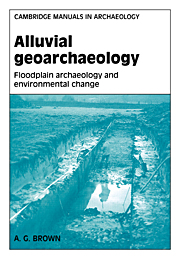Book contents
- Frontmatter
- Contents
- List of illustrations
- List of tables
- Preface
- Acknowledgements
- Introduction and the example of the Nile
- PART I PRINCIPLES
- 1 Floodplain evolution
- 2 Alluvial environments over time
- 3 Interpreting floodplain sediments and soils
- 4 Floodplain ecology, archaeobotany and archaeozoology
- PART II APPLICATION
- APPENDICES
- References
- Subject Index
- Index of rivers and sites
4 - Floodplain ecology, archaeobotany and archaeozoology
Published online by Cambridge University Press: 03 December 2009
- Frontmatter
- Contents
- List of illustrations
- List of tables
- Preface
- Acknowledgements
- Introduction and the example of the Nile
- PART I PRINCIPLES
- 1 Floodplain evolution
- 2 Alluvial environments over time
- 3 Interpreting floodplain sediments and soils
- 4 Floodplain ecology, archaeobotany and archaeozoology
- PART II APPLICATION
- APPENDICES
- References
- Subject Index
- Index of rivers and sites
Summary
This chapter examines the ecological characteristics of floodplains, how these are related to environmental parameters and how past environmental conditions can be reconstructed from organic materials preserved within floodplain sediments. The implications for past cultures lie in the resources that these ecologies provide at different times and in different places.
Floodplain productivity
Floodplains are more productive than the land that surrounds them owing to the greater availability of water and nutrients. However, their productivity still varies with latitude and local climatic factors. The net above-ground primary productivity of a forested fen in Minnesota has been measured as 746 g m2 yr–1 while that of a Louisiana bottomland hardwood forest is 1374 g m2 yr–1 (Mitsch and Gosselink, 1993). Net productivity and the difference between floodplain productivity and that of surrounding land is controlled by water supply. In the humid tropics where there is abundant year-round water this difference is minimised and the floodplain margin may not be an obvious ecological feature (Figure 4.1). As seasonal contrasts increase and rainfall decreases in the subtropical climates, the difference is at its maximum because of the greater supply and storage of water in floodplains. In Cool Temperate zones the contrast is smaller and differences in soil type and agricultural potential become more important. In the Boreal zone disturbance of vegetation by highly active rivers complicates the situation. The difference between floodplain net primary productivity and dryland net primary productivity structures the rest of the ecosystem, increasing both animal and plant resources.
- Type
- Chapter
- Information
- Alluvial GeoarchaeologyFloodplain Archaeology and Environmental Change, pp. 104 - 146Publisher: Cambridge University PressPrint publication year: 1997

